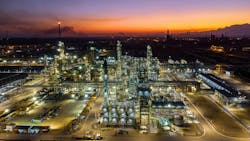Petrobras doubles processing capacity of Route 3 gas plant
Petróleo Brasileiro SA (Petrobras) has fully commissioned its new natural gas processing unit (UPGN) at the Boaventura energy complex in Itaborai, Rio de Janeiro, Brazil, as part of the operator’s Route 3 integrated project (PIR3) to expand transportation and processing of associated gas from the country’s offshore Santos basin presalt (OGJ Online, Mar. 27, 2023; Nov. 7, 2022, p. 40).
On May 4, Petrobras began commercially operating the complex’s second 10.5-million cu m/day processing train, bringing the Boaventura UPGN’s overall processing capacity of natural gas from the Santos basin presalt cluster to 21 million cu m/day, the operator said on May 5.
The plant—which receives its rich-gas feedstock via the new 355-km 18-million cu m/day PIR3 pipeline (307 km offshore, 48 km onshore) from production fields such as Tupi, Búzios, Sapinhoá, among others—generates at least three important derivatives for the regional market, including natural gas and LPG (cooking gas) for commercial and residential applications, as well as C5+ for use as a raw material in both petrochemical and fuel production, Petrobras said.
The company said its now fully commissioned Boaventura UPGN forms a critical element in supporting Petrobras’ combined PIR3 project goal of increasing cleaner energy supplies to the Brazilian market in line with a low-carbon future while simultaneously commercializing associated gas production from the presalt cluster to help reduce the country’s dependence on imports.
"[Startup of commercial operations at Bonaventura UPGN’s second train] is also essential to [increasing] Petrobras' competitiveness in the new dynamic and competitive environment of the national gas market," said Maurício Tolmasquim, the company’s director of energy transition and sustainability.
Alongside increasing supplies to Brazil’s domestic market, the PIR3 project—in addition to increasing presalt-flow capacity—also brings greater flexibility to Petrobras operations since, regardless of the connection point, gas from Santos basin production fields can also be routed to the company's other processing units, said Renata Baruzzi, Petrobras’ director of engineering, technology, and innovation.
Startup of Bonaventura UPGN’s Train 2 follows commission of the complex’s 10.5-million cu m/day Train 1 in late 2024 (OGJ Online, Nov. 11, 2024).
Petrobras confirmed last year that it signed more than 34 natural gas-supply contracts in 2023 that would account for more than 70 billion cu m in sales planned up to 2034.
Ongoing works
Upon announcing startup of Train 2, Petrobras said development remains ongoing for other projects within the Bonventura complex, including two gas-fired thermoelectric plants to enable participation in an upcoming auction planned for the electricity sector on June 27.
Petrobras also confirmed its has entered the contracting phase for units that will produce low-sulfur fuels and API Group II/II+ lubricating base oils based using a feedstock of intermediate products delivered via pipeline from the operator’s nearby 239,000-b/d Duque de Caxias (REDUC) refinery in the Baixada Fluminense area of Rio de Janeiro (OGJ Online, Sept. 12, 2024).
Most recently slated to begin construction and assembly in 2025, Petrobras said these future units at the Bonventura complex will have capacity to produce the following:
- 12,000 b/d of Group II base oils.
- 75,000 b/d of low-sulfur (10 ppm) S-10 diesel.
- 20,000 b/d of aviation kerosine (QAV-1), or jet fuel.
About the Author
Robert Brelsford
Downstream Editor
Robert Brelsford joined Oil & Gas Journal in October 2013 as downstream technology editor after 8 years as a crude oil price and news reporter on spot crude transactions at the US Gulf Coast, West Coast, Canadian, and Latin American markets. He holds a BA (2000) in English from Rice University and an MS (2003) in education and social policy from Northwestern University.

